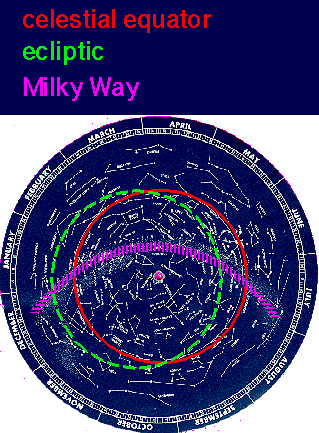
The Milky Way is a diffuse band of light that crosses the entire sky. We now know that this band of light is in fact the combined light of billions of stars which, along with the Sun, are in the same plane. When we look in this plane (i.e., at the Milky Way) we see innumerable (relatively distant and dim) stars ; when we look out of this plane (i.e., in any other direction) we see dozens of (relatively nearby and bright) stars that make up most constellations. Even the most distant stars in the Milky Way are close compared to the stars in other galaxies, but that's another topic.
The brightest objects in the sky (Sun, Moon, other planets) have no white dot on the star map to show their position. That's because instead of having fixed positions these objects (let's simply call them "planets") move around. Some times a planet my be near the star Spica, other times near the star Regulus, etc. But all of the time planets are found near the imaginary line called the ecliptic. (Click here for another explanation of this term, but remember to return Back here.) Thus if you see a bright "star" that's not shown on the star map, but which is near the area labeled "ecliptic", it's probably a planet. To find out which planet it is, find the Planet Places table on the back of the star finder, similar to the below:
2012 JAN FEB MAR APR MAY JUN JUL AUG SEP OCT NOV DEC Mercury MOR EVE EVE MOR - EVE EVE MOR MOR - EVE MOR Venus EVE EVE EVE EVE EVE - EVE EVE EVE EVE EVE MOR Mars LEO VIR LEO LEO LEO LEO VIR VIR VIR LIB OPH SGR Jupiter PSC ARI ARI ARI ARI TAU TAU TAU TAU TAU TAU TAU Saturn VIR VIR VIR VIR VIR VIR VIR VIR VIR VIR VIR VIRThis chart tells in which constellation these five planets will be found on each month of the year. Thus in 2012 Jupiter moves from the constellation Pisces, through Aries and into Taurus. Saturn is in Virgo all of 2012. Mars moves from Leo to Sagittarius during the year. Note the constellation numbers provided: Aries (1), Taurus (2), Gemini(3), Cancer (4), Leo (5), Virgo (6), Libra (7), Scorpius (8), Ophiuchus (9), Sagittarius (10), Capricornus (11), Aquarius (12) and Pisces (13). As viewed from Earth, the inner planets Mercury and Venus are in nearly the same direction as the Sun. As a result they are usually seen in the evening (EVE) or morning (MOR).
